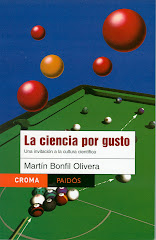Published in Milenio Diario, October 14th, 2009
 The chemistry Nobel prize thrilled me even more than the one for Medicine.
The chemistry Nobel prize thrilled me even more than the one for Medicine.It was given to Venkatraman Ramakrishnan (Hindu, nationalized American, but living in
If, like I mentioned last week, enzymes are amazing molecular machines that practically carry out all the functions of a living cell, ribosomes are an real automatized factories that manufacture, with absolute precision, each one of the thousands of different proteins we need to be alive.
A ribosome is a complex structure made of ribonucleic acid (the one-strand cousin of DNA) and many proteins.
It has some fixed parts, and other that move with robotic precision to assemble, in a matter of minutes, and from reading the information coming from DNA, proteins made up by thousands of amino acids, strung together as pearls in a necklace.
The achievement of the Nobel winners was to localize with great precision each one of the hundreds of thousands of atoms that form a ribosome, and this has allowed them to understand their functioning in atomic detail. They used X ray crystallography, a technique developed in the beginning of the 20th century (and the same one that allowed Watson and Crick to discover the DNA double helix structure in 1953 --a structure, I might add, infinitely simpler than a ribosome).
To achieve this, they first had to obtain perfectly arranged crystals formed by pure ribosomes. It took them almost 20 years.
But to see atoms, one cannot use an optical microscope, not even an electron microscope. Only X rays have the necessary finesse. And no lens can focus them to form images: you have to gather the group of stains formed as the X rays travel through the crystals (originally the stains were captured on photographic film, but today they are captured by a couple charged device or CCD, the invention that this year won the Physics Nobel prize) and using computers to mathematically process data.
The result? Computerized models that reveal, with a very high level of detail, each screw and bolt of these wonderful molecular nano-factories.
As an additional benefit, these models are allowing scientist to develop new antibiotics that work like monkey wrenches tossed into the ribosomes of bacteria that make us sick.
Yes, I loved this year's chemistry Nobel. Too bad that Harry Noller, one of the giants of ribosome research, was left out of the prize, which can only be given to three persons.
(translated by Adrián Robles Benavides)
To receive Science for pleasure weekly
in your email, subscribe here!





No comments:
Post a Comment